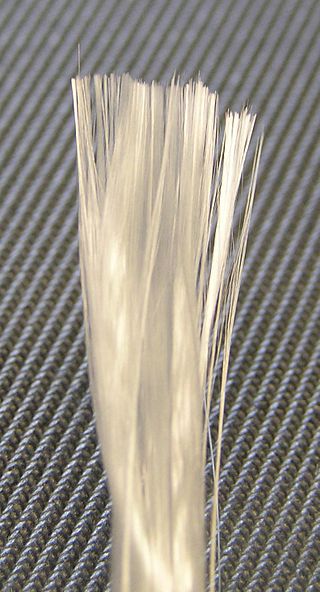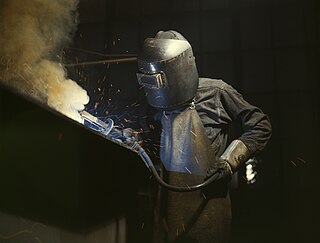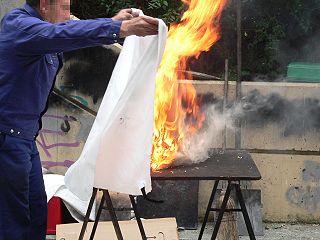Related Research Articles

Personal protective equipment (PPE) is protective clothing, helmets, goggles, or other garments or equipment designed to protect the wearer's body from injury or infection. The hazards addressed by protective equipment include physical, electrical, heat, chemical, biohazards, and airborne particulate matter. Protective equipment may be worn for job-related occupational safety and health purposes, as well as for sports and other recreational activities. Protective clothing is applied to traditional categories of clothing, and protective gear applies to items such as pads, guards, shields, or masks, and others. PPE suits can be similar in appearance to a cleanroom suit.

Glass fiber is a material consisting of numerous extremely fine fibers of glass.
Fiberglass or fibreglass is a common type of fiber-reinforced plastic using glass fiber. The fibers may be randomly arranged, flattened into a sheet called a chopped strand mat, or woven into glass cloth. The plastic matrix may be a thermoset polymer matrix—most often based on thermosetting polymers such as epoxy, polyester resin, or vinyl ester resin—or a thermoplastic.

A welder is a person or equipment that fuses materials together. The term welder refers to the operator, the machine is referred to as the welding power supply. The materials to be joined can be metals or varieties of plastic or polymer. Welders typically have to have good dexterity and attention to detail, as well as technical knowledge about the materials being joined and best practices in the field.

Submerged arc welding (SAW) is a common arc welding process. The first SAW patent was taken out in 1935. The process requires a continuously fed consumable solid or tubular electrode. The molten weld and the arc zone are protected from atmospheric contamination by being "submerged" under a blanket of granular fusible flux consisting of lime, silica, manganese oxide, calcium fluoride, and other compounds. When molten, the flux becomes conductive, and provides a current path between the electrode and the work. This thick layer of flux completely covers the molten metal thus preventing spatter and sparks as well as suppressing the intense ultraviolet radiation and fumes that are a part of the shielded metal arc welding (SMAW) process.

A hard hat is a type of helmet predominantly used in workplace environments such as industrial or construction sites to protect the head from injury due to falling objects, impact with other objects, debris, rain, and electric shock. Suspension bands inside the helmet spread the helmet's weight and the force of any impact over the top of the head. A suspension also provides space of approximately 30 mm between the helmet's shell and the wearer's head, so that if an object strikes the shell, the impact is less likely to be transmitted directly to the skull. Some helmet shells have a mid-line reinforcement ridge to improve impact resistance. The rock climbing helmet fulfills a very similar role in a different context and has a very similar design.

Arc welding is a welding process that is used to join metal to metal by using electricity to create enough heat to melt metal, and the melted metals, when cool, result in a binding of the metals. It is a type of welding that uses a welding power supply to create an electric arc between a metal stick ("electrode") and the base material to melt the metals at the point of contact. Arc welding power supplies can deliver either direct (DC) or alternating (AC) current to the work, while consumable or non-consumable electrodes are used.
This page is a list of construction topics.

Eye protection is protective gear for the eyes, and sometimes face, designed to reduce the risk of injury. Examples of risks requiring eye protection can include: impact from particles or debris, light or radiation, wind blast, heat, sea spray or impact from some type of ball or puck used in sports.
Harbor Freight Tools, commonly referred to as Harbor Freight, is an American privately held tool and equipment retailer, headquartered in Calabasas, California. It operates a chain of retail stores, as well as an e-commerce business. The company employs over 26,000 people in the United States, and has over 1,500 locations in 48 states.

A fire blanket is a safety device designed to extinguish incipient (starting) fires. It consists of a sheet of a fire retardant material that is placed over a fire in order to smother it.

Building insulation materials are the building materials that form the thermal envelope of a building or otherwise reduce heat transfer.

In construction, asbestos abatement is a set of procedures designed to control the release of asbestos fibers from asbestos-containing materials. Asbestos abatement is utilized during general construction in areas containing asbestos materials, particularly when those materials are being removed, encapsulated, or repaired. Abatement is needed in order to protect construction workers and members of the general public from the many negative health impacts of asbestos.

Oxy-fuel welding and oxy-fuel cutting are processes that use fuel gases and oxygen to weld or cut metals. French engineers Edmond Fouché and Charles Picard became the first to develop oxygen-acetylene welding in 1903. Pure oxygen, instead of air, is used to increase the flame temperature to allow localized melting of the workpiece material in a room environment.

Asbestos is a naturally occurring fibrous silicate mineral. There are six types, all of which are composed of long and thin fibrous crystals, each fibre being composed of many microscopic "fibrils" that can be released into the atmosphere by abrasion and other processes. Inhalation of asbestos fibres can lead to various dangerous lung conditions, including mesothelioma, asbestosis, and lung cancer. As a result of these health effects, asbestos is considered a serious health and safety hazard.

An ironworker is a tradesman who works in the iron-working industry. Ironworkers assemble the structural framework in accordance with engineered drawings and install the metal support pieces for new buildings. They also repair and renovate old structures using reinforced concrete and steel. Ironworkers may work on factories, steel mills, and utility plants.

Eric L. Smidt is an American businessman. He is chairman and CEO of Harbor Freight Tools, which operates over 1,500 retail hardware stores in 48 states and generates $8 billion in sales as of 2023.
Zetex fabrics were invented by Bal Dixit in 1978. This highly texturized fiberglass fabric exhibits many of the same properties as asbestos, such as resistance to heat, corrosion and rot resistance, outstanding electrical properties, ability to withstand molten metal, and thermal insulation. However, it does not carry the same health risks.

In rail transport, the U.S. DOT-111 tank car, also known as the TC-111 in Canada, is a type of unpressurized general service tank car in common use in North America. Tank cars built to this specification must be circular in cross section, with elliptical, formed heads set convex outward. They have a minimum plate thickness of 7⁄16 inch (11.1 mm) and a maximum capacity of 34,500 US gallons. Tanks may be constructed from carbon steel, aluminum alloy, high alloy steel, or nickel plate steel by fusion welding.
References
- ↑ Harbor Freight Tools. "Fiberglass Welding Blanket". Harbor Freight Tools. Retrieved 2015-05-29.
- ↑ Skinner, Mark C.; Schwartz, Thomas W. (1989-07-18), Welding blanket , retrieved 2015-05-29
- ↑ Sokolove Law. "Asbestos in Welding Blankets -". Asbestos.net. Retrieved 2015-05-29.